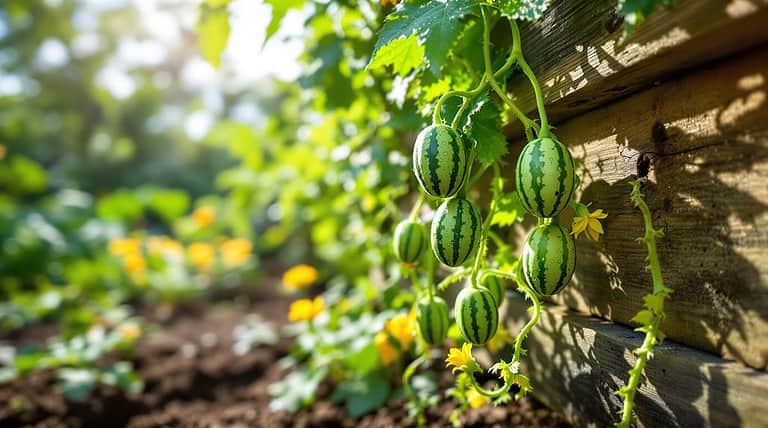Vine Plant With Orange Flowers: Add Color to Your Garden
Orange-flowering vines can alter your garden with lively color and vertical interest. Popular options include Tangerine Beauty Crossvine, Flamenco Trumpet Vine, and Mexican Flame Vine. These plants thrive in full sun and well-drained soil, requiring regular watering and fertilization for peak growth.
To accommodate their climbing nature, you must provide sturdy support structures, such as trellises or arbors. Prune after blooming to maintain shape and encourage vigorous growth. When selecting a vine, consider your hardiness zone and garden style.
Be cautious of invasive tendencies, particularly with Trumpet Vine. With proper care and maintenance, these stunning vines will add an energetic, eye-catching element to your outdoor space. Exploring further will reveal more observations about cultivating these colorful climbers.
TLDR
- Tangerine Beauty Crossvine offers hardy, non-invasive orange blooms and adapts to various light conditions.
- Flamenco Trumpet Vine provides bright orange flowers but requires caution due to potential invasiveness.
- Mexican Flame Vine attracts butterflies and hummingbirds and thrives in drought conditions, but is toxic to pets.
- Orange-flowering vines need full sun, well-draining soil, and regular deep watering for vibrant blooms.
- Proper pruning, training on sturdy trellises, and companion planting enhance the visual appeal of orange vine flowers.
Selecting Orange-Flowering Vines

When selecting orange-flowering vines, you have several stunning options to consider. The Tangerine Beauty Crossvine and Flamenco Trumpet Vine are climbing vines that thrive in full sun and offer fast growth, making them excellent choices for adding lively color to your garden.
Additionally, consider the durability and longevity of these plants, similar to the qualities seen in premium toolboxes like those from Snap-on, known for their high quality and durability. When choosing, consider your hardiness zone and garden style.
Be cautious of invasive tendencies, especially with the Trumpet Vine. The Mexican Flame Vine is drought-tolerant but toxic to pets, while Crossvine adapts well to various light conditions.
Popular Orange Vine Species
Several popular orange vine species can alter your garden with their dynamic blooms and climbing nature. Vines like Tangerine Beauty Crossvine are hardy and non-invasive and provide an excellent way to enhance your garden’s aesthetics while requiring minimal maintenance, similar to how Toro Recycler mowers offer effortless lawn care.
The best flowering vines include Tangerine Beauty Crossvine, which is hardy and non-invasive, and Flamenco Trumpet Vine, known for its bright orange flowers. Mexican Flame Vine attracts butterflies and hummingbirds, while Firecracker Vine offers striking blooms. Orange Morning Glory, though beautiful, is invasive and toxic to humans.
Planting and Care Tips

To successfully grow orange flowering vines, you must contemplate key factors like soil, sunlight, and care routines. It’s important to ascertain that the soil remains well-aerated to promote healthy root growth, as compacted soil can hinder nutrient absorption and water penetration.
You should plant these lively climbers in well-draining soil and provide them with full sun to partial shade for ideal growth. Regular watering, especially during dry spells, along with spring fertilization and proper pruning, will help your orange vines thrive and produce stunning blooms.
Additionally, incorporating regular aeration into your care routine can greatly enhance soil structure and support sturdy plant health.
Soil and Sun Requirements
Success with orange flowering vines starts with proper soil and sun conditions. These showy flowering vines thrive in well-drained, nutrient-rich, and slightly acidic soil.
They need full sun exposure, at least 6-8 hours daily, for vigorous blooming. Maintain proper soil moisture by watering deeply but infrequently. Enhance soil fertility with organic compost and apply a balanced fertilizer every 6-8 weeks during the growing season for peak growth and lively flowers.
Watering and Fertilization
How often should you water and fertilize your orange-flowering vines? Water deeply and consistently, keeping soil moist but not waterlogged. During dry spells, water at least weekly. Apply a balanced, slow-release fertilizer in early spring for healthy growth and lively blooms.
You can supplement with liquid fertilizer every 4-6 weeks during the growing season. Monitor soil moisture and adjust watering based on rainfall and heat to guarantee ideal vine conditions.
Pruning and Training
Beyond proper watering and fertilization, effective pruning and training are key to maintaining healthy, beautiful orange-flowering vines. Prune after blooming to shape and promote vigorous growth. Train vines on trellises or arbors to encourage upward growth and maximize flower exposure.
Remove dead stems regularly to enhance health and appearance. Install support structures at planting to avoid root disturbance. These practices guarantee your vines thrive and produce abundant, lively blooms.
Trellis and Support Structures
Proper support is essential for its health and visual appeal when growing a vine plant with orange flowers. Vines grow quickly; a sturdy trellis or support structure will help your bright flowering plant thrive. To prevent damage to your trellis, make certain that it is properly anchored and can withstand the weight of the vine as it matures, especially during harsh weather conditions that may cause deck wood splitting.
Install your trellis when you plant the vine to avoid root disruption. Choose from various styles like lattice or arched designs to complement your garden’s aesthetic while supporting your vine as it reaches up to 30 feet.
Companion Plants for Orange Vines

A harmonious garden design comes to life when you pair your orange flowering vines with complementary companion plants. Consider lively options like Purple Bell Vine or Coral Honeysuckle to visually contrast and attract pollinators.
Add low-maintenance annuals such as Marigolds for summer-long color. Incorporate perennials like Echinacea or Black-Eyed Susans for a multi-layered effect. Silver-foliage plants like Dusty Miller can enhance the brightness of your orange blooms.
Seasonal Considerations and Maintenance
While companion planting enhances your garden’s beauty, proper seasonal care guarantees your orange flowering vines thrive year-round.
Plant your vine after the last frost in spring, ensuring it’s in the right hardiness zone. For beautiful flowering, provide full sun and well-drained soil. Regular maintenance, including pruning and fertilizing, helps your vine grow well. Monitor soil moisture and control aggressive growth to keep your orange-flowered vine healthy and lively.
Overall
You’ve now learned how to add lively orange-flowering vines to your garden. You’ll create a stunning vertical display by selecting the right species, providing proper care, and using suitable support structures.
Remember to contemplate companion plants and seasonal needs for a well-rounded garden. With regular maintenance and attention to your vines’ specific requirements, you’ll enjoy a colorful, eye-catching scenery that thrives year after year. Your garden will become a beautiful, orange-accented oasis.







